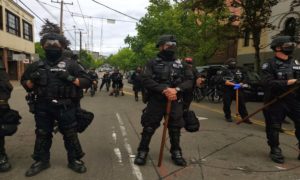Seattle Public Schools operates 18 High Schools all over the city, ranging all the way from Chief Sealth in Southern West Seattle to Nathan Hale in Northern Seattle. With over 25,000 public high school students, 18 schools should be sufficient enough to educate these young minds and provide them with the opportunity to obtain a high school diploma or GED, or even help to receive direct acceptance to a prestigious school like the University of Washington. Unfortunately, there are detrimental inconsistencies within Seattle Public High Schools that continuously have a negative effect on students of color and economically disadvantaged families, specifically in the South side of Seattle.
There is no getting around it: the South end is nowhere near as wealthy or as White as the North end. Franklin High School in the Mount Baker neighborhood, where I am currently enrolled, is 72% economically disadvantaged, with a 92% minority enrollment, whereas 12 miles North, Ingraham High School is only 29% economically disadvantaged and has a 45% minority enrollment, according to USNews. Both schools have nearly the same total enrollment and similar teacher-to-student ratios. So why does one school receive more funding from the district than the other? The math is simple: schools in wealthier neighborhoods will receive more funding from affluent families, therefore the school can provide more materials, programs, and faculty. The students thrive off these greater opportunities, performing well on their standardized testing, thus earning their school even more funding from the district, and the cycle continues. For example, according to a KUOW article on HBO’s Problem Areas, “The episode focuses on Rainier Beach High School, where the PTA has $2,000 in its coffers, compared with the $3.5 million at Roosevelt High School in the city’s much wealthier and whiter north end.” In 2013, Garfield High School parents offered an $85,000 Tesla S Sedan in their annual auction, selling 1,650 raffle tickets at $100 a piece, according to a source at West Seattle Blog. These luxuries are provided by the wealthier families that take part in a school’s PTA—these parents can step in and provide extra cash when the district’s funding falls short. In a KUOW Article, Chandra Hampson, the head of the Seattle PTSA, is quoted as saying,“You don’t expose the inequities until you pull back the PTA funding.”
A few months ago, I had the opportunity to join a family friend at her school, Ballard High, for a Franklin versus Ballard basketball game. Simply walking through the hallways of her school, I was amazed at the height of the ceilings, the cleanliness of the floors, and the bright colors of red and white that sparkled like new. Thinking back to my High School, Franklin, it’s yellowed laminate floors, paper shortages, and constant smell of sawdust from the woodshop, I felt ashamed. All embarrassment was lost, however, when the Franklin Quakers defeated the Ballard Beavers in the final seconds of the game. You can buy good test scores, but you can’t buy quality, honest, hardworking students.
Alongside walking through the halls of Ballard High School, I watched Garfield High School swipe the 2018 Washington State Basketball Championships from Rainier Beach High School, and I watched my friends in my quickly gentrifying neighborhood ship themselves off to schools like Holy Names and Seattle Prep, and even Garfield High School, to evade the poor quality of Franklin’s or Rainier Beach’s education. This is through the use of the SPS School Choice, which was originally created to help disadvantaged families send their kids to better schools, but rather inspired white flight for white students to attend better-funded schools outside their school district. Parents that claim they just want the best for their children are ignorant of the Black and Brown students just 30 minutes South of them, who are struggling to make daily living wages just so they can attend a public school with broken chairs, water-damaged textbooks, and a teaching staff that is getting along just barely more than they are. This reality of the inequalities and inconsistencies throughout the Seattle Public Schools system should not be tolerated or accepted, no child’s education should be valued more than others because of how their parents’ privilege benefits them.
Fortunately, there is hope for a brighter future for disadvantaged students in Seattle. The Seattle Education Action Plan calls for the improvement of school climate, in-school instruction and programming, and family/community engagement and partnerships, the support of community and family needs, and much more. There is emphasis on eliminating the education gap (of which Washington’s is the fifth largest in the country), ending the school-to-prison pipeline, and clearly lays out how this plan will be funded due to the revenue from the new Sweetened Beverage Tax. “For these investments to be fruitful, we must remain cognizant of the social, historical and economic contexts that have hindered success for our low-income students and students of color.” The Seattle Education Action Plan fails to state when exactly the plan will be fully implemented, but with diligent focus and government officials’ support, I am hopeful that high schools like Franklin and Rainier Beach will be able to provide the same support and education services that Ingraham and Garfield can.






Comments are closed.